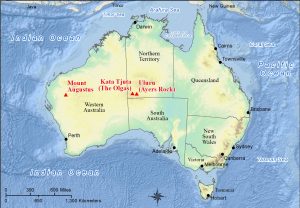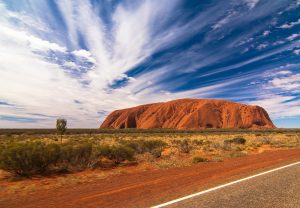16 Pacific Realm: Physical Geography I – Monoliths

The word monolith derives from the Greek words meaning single and stone. Mono is found in numerous English words, such as monopoly (a single company that dominates a resource, commodity, or product) and monorail (a tram that runs on a single rail, like in Seattle). Lith is less common, but lithosphere refers to the rocky outer layer of the Earth.
While monolith refers to a single stone, it does so not in the casual mundane way. You can pick up a single stone off the street, but it is not a monolith. There are innumerable grains of sand and millions of pebbles on the beach, but those are not monoliths. In this context, perhaps a better word for mono is singular. A monolith is a stone of great size set distinctly alone in a striking location. A monolith is a rocky singularity on the Earth’s surface.

Cartography by Steve Wiertz.
It seems most logical that a monolith has been thrust upward in some ancient geological movement. While this may be true in certain cases or to some degree, it is best understood that the monoliths remain on the landscape due to erosion. Or more clearly, as single masses of particularly hard metamorphic or igneous rock, monoliths remain on the landscape while adjacent rock or soil material over eons of time has been subjected to sufficient water or wind erosion to be moved away. The massive strongly resistant rock endures.
There are monoliths all across the world. In America, the well-known monoliths are Stone Mountain outside of Atlanta, Devil’s Tower in Wyoming, and El Capitan in Yosemite National Park.

Nevertheless, Australia is particularly known for its few monoliths. Perhaps this recognition is due to Australia highlighting its large barren Outback, while having only a small set of low mountains. A cluster in the Northern Territory originally was named by the aborigines as Kata Tjuta, meaning many heads – see the aerial and satellite photos below. Later rediscovered by the British, it was renamed “the Olgas.” Under current Australian law of dual naming, it is known by both names.

The most famous monolith in Australia was named Uluru by the aborigines. Later rediscovered by the British, it was renamed Ayers Rock. Both Kata Tjuta / the Olgas and Uluru/Ayers Rock have distinctive orange hues that result from oxidation of iron material in the rock. Given appropriate sunrises or sunsets and when viewed from a particular angle, Uluru may appear to glow. In 1985, as part of a series of land recoveries by the aboriginal peoples, legal title of Uluru was restored to the local Pitjantjatjara group. Tourism is an important feature of Uluru, though climbing of the monolith has now been banned as of the end of October 2019.

The world’s largest monolith is in Australia, but is it Uluru or is it Mount Augustus? The latter sits in Western Australia and is twice the volume as Uluru. The dispute focuses on whether or not Mount Augustus is a monolith. In the casual use of the term monolith, Mount Augustus is included in this rocky set of places. In tourist literature in Western Australia, Mount Augustus is promoted as the world’s largest monolith. However, in geologic study, Mount Augustus is cited as a monocline. A monocline is an asymmetrical series of folded rock layers. Indeed, this created Mount Augustus in an ancient geologic buckling movement, likely over a billion years ago. It is safe to say that Mount Augustus is the world’s biggest surface rock. If Mount Augustus is excluded from the monolith category, then Uluru is the world’s biggest monolith. Either way, Australia has the title holder.
Did You Know?
Megaliths are large standing stones set vertically in the ground by people. The famous cluster known as Stonehenge is a set of megaliths.
The word monolith can have other meanings in different contexts. A monolith can be a massive structure, not necessarily a natural rock formation. A monolith can be a singularly powerful or unified force.
Perhaps because of these other meanings, some scholars prefer to include formations like Uluru under the term inselberg.
Hot Off the Press
Uluru does not receive much rainfall, but the occasional downpour can create multiple waterfalls, as noted in this 2022 news article. https://explorersweb.com/uluru-waterfall/
Cited and additional bibliography:
Collis, Steve. 2016. Kata Tjuta. https://tinyurl.com/katatutja. Attribution 2.0 Generic (CC BY 2.0).
Rivera, Larry. 2019. “Your Guide to Mt. Augustus in Australia, the World’s Largest Rock.” TripSavvy. June 29, 2019. http://www.tripsavvy.com/mt-augustus-western-australia-1464689.
Wiertz, Steve. 2020. “Monoliths.” College of DuPage. College of DuPage GIS class. Instructor Joseph Adduci.
Williams, Lisa Maree, and Babak Tafreshi. 2019. “Why Australia Is Banning Climbers from This Iconic Natural Landmark.” Travel. September 12, 2019. http://www.nationalgeographic.com/travel/destinations/oceania/australia/uluru-closing-why-it-matters/.

